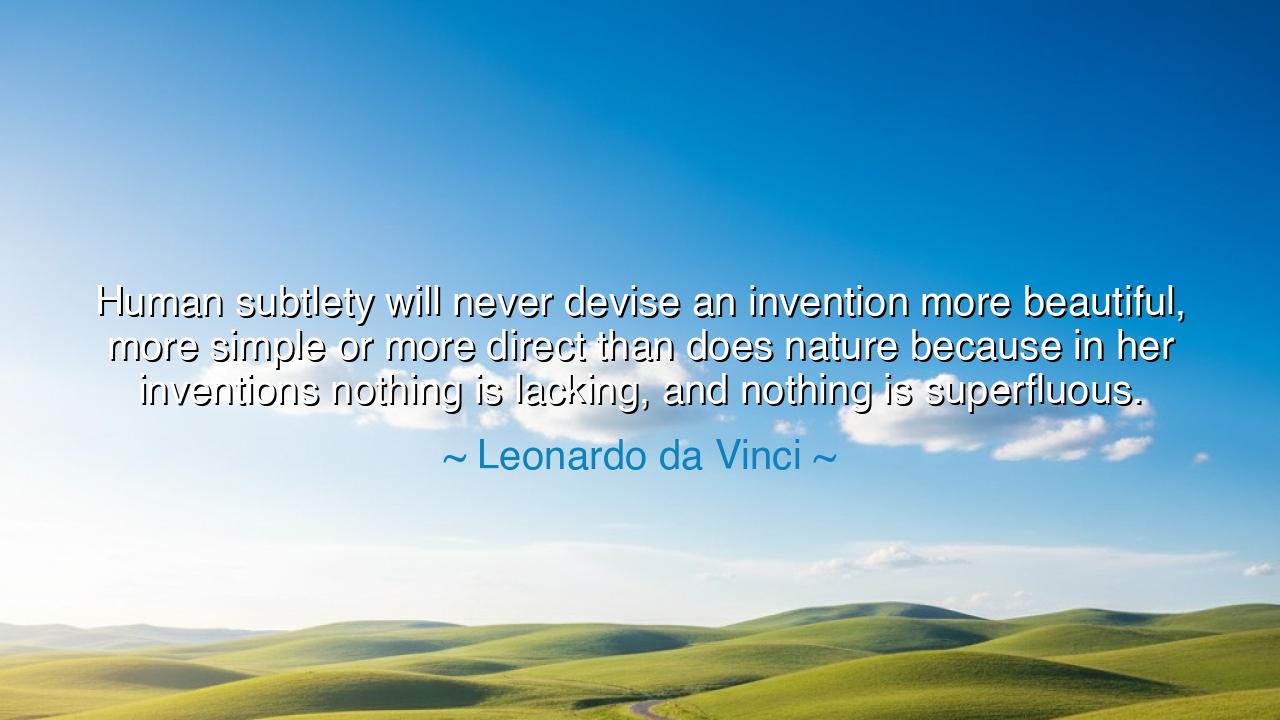
Human subtlety will never devise an invention more beautiful
Human subtlety will never devise an invention more beautiful, more simple or more direct than does nature because in her inventions nothing is lacking, and nothing is superfluous.






Leonardo da Vinci, that giant among thinkers, artists, and inventors, once proclaimed: “Human subtlety will never devise an invention more beautiful, more simple, or more direct than does nature, because in her inventions nothing is lacking, and nothing is superfluous.” In these words, he places humanity’s proudest achievements beside the quiet majesty of the natural world and shows us how small our efforts appear in comparison. For all our craft and labor, the work of nature is perfect—balanced, efficient, and filled with a beauty we cannot replicate.
The meaning of this quote is clear and humbling. Leonardo, himself a master of invention and design, understood that the truest engineer is nature itself. The wings of birds, the spiral of seashells, the veins of leaves—all are marvels of function and form, achieving with ease what humanity struggles to approximate with tools and machines. Our inventions, however ingenious, often contain flaws, excess, or waste. But in nature, there is nothing extra, nothing missing—only perfection in purpose.
The origin of this thought lies in Leonardo’s own life. He was a tireless observer of the natural world, filling his notebooks with studies of plants, animals, bones, rivers, and skies. He sought to design machines that could fly like birds, weapons that harnessed natural forces, and bridges that mirrored organic forms. Yet in all his genius, he was never blind to the truth: that all his efforts were but imitations, pale reflections of the harmony already present in the world around him. His humility before nature was the foundation of his greatness.
History offers us proof of Leonardo’s wisdom. Consider the Wright brothers, who built the first flying machine. They did not simply invent from imagination; they studied birds, observing how wings curved and adjusted to currents. Their success came not from defying nature, but from learning from it. Even in our modern age, scientists study the structure of sharkskin to design faster swimsuits, the web of spiders to create stronger fibers, and the hive of bees to design efficient architecture. Again and again, humanity’s progress is not born from surpassing nature, but from imitating her.
Leonardo’s words also carry a spiritual weight. In them is a call to humility. For too often, humankind exalts itself as master of the earth, striving to dominate and reshape the world. Yet Leonardo reminds us that in nature’s inventions there is a wisdom greater than our own, a wisdom that has endured for millennia. To see a tree or a bird is to see a miracle of design beyond any cathedral or machine. To recognize this is not to diminish our creativity, but to place it in its rightful role—as students of the master, not rivals to it.
The lesson is profound: if we would be true creators, we must first be true observers. Instead of forcing our will upon the world, let us learn from its patterns. The curve of a river teaches us about flow; the form of a flower teaches us about beauty; the resilience of a forest teaches us about balance. Our inventions must not fight nature, but harmonize with it. In this lies both wisdom and survival.
Practically, this means cultivating eyes to see and hearts to respect. Study the natural world with reverence, not merely as raw material for use, but as teacher and guide. Let engineers design with the economy of the seashell, let artists paint with the balance of the leaf, let leaders govern with the harmony of the ecosystem. And in daily life, live simply, avoiding waste, for nature shows us that true perfection leaves nothing superfluous.
So remember Leonardo’s teaching: no invention of man will ever surpass the inventions of nature. All our genius is but the echo of her voice, all our creations but the shadow of her designs. To honor her, to learn from her, to live in harmony with her—this is the path of wisdom. For in her, nothing is lacking, nothing is wasted, and in her lies the eternal blueprint for beauty, strength, and truth.






AAdministratorAdministrator
Welcome, honored guests. Please leave a comment, we will respond soon